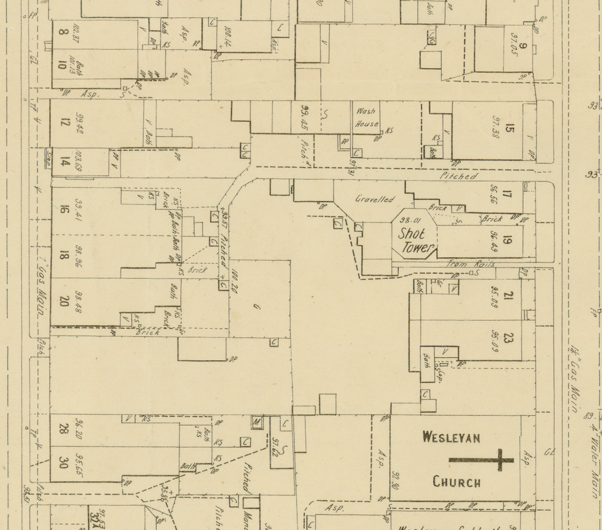Collingwood Notables Database
Eugen Louis Hamel
c. 1827-1900
Lead shot maker
Referred to variously as Louis, Eugene Louis, and Eugen Louis, Hamel was the owner and operator of Collingwood’s first shot tower, built before Richard Hodgson’s well-known shot tower in Clifton Hill, but demolished many years ago.
Hamel originated from Prussia where he was living in Gnada prior to sailing from Hamburg, arriving on the Macassar in 1859. At this time many Wendish people sought to escape from religious persecution in the Prussian state, and a significant number of Germans settled in Collingwood and Abbotsford.
 By 1863 Hamel was living in Collingwood and making his living as a dealer. His shot tower, located towards the rear of 19 Sackville Street, was constructed in 1877-78. Tram rails ran from the factory to Sackville St in a lane next to his two storey residence, which was at number 21.
By 1863 Hamel was living in Collingwood and making his living as a dealer. His shot tower, located towards the rear of 19 Sackville Street, was constructed in 1877-78. Tram rails ran from the factory to Sackville St in a lane next to his two storey residence, which was at number 21.
The Illustrated Australian News reported on 27 December 1877 that Hamel’s shot tower was almost completed, was to be 128 feet high and was the only one in Australia other than one in Hobart.
The Mercury and Weekly Times described on 2 March1878 Hamel’s intended method, the tower being close to completion, and some potential difficulties:
… the composition with which the shot is made is first melted in a building adjoining the tower. About 13 cwt. of metal is melted at a time, and takes six hours before it is turned out into the ingot moulds. Three hours are required for melting and three for the metals to amalgamate. These ingots of amalgam are then sent to the summit of the tower, per windlass, and there melted again. When sufficiently melted the liquid metal is poured into a colander which is fixed into a frame held over the mouth of the well. The holes in the colanders used are pierced according to the size of shot required …. The metal having dropped from the summit of the tower into the well, the water therein is pumped out and a man goes down in a bucket and brings the shot to the surface. It is then dried and run off into a trough, passing over on its way various sieves, so that there may be no mixing of sizes. From this trough it is passed into a long cylindrical screw fitted with ten different sizes of sieves, fitted over … hoppers protected by shrouds. From these … the shot is put into a barrel, which being swiftly turned gives the necessary polish. From this barrel the shot is weighed and packed. … unless a proper amalgam is secured, instead of the shot falling into the well, it scatters and falls on a floor some distance from the ground erected for such a contingency. The weather also materially affects the proper manufacture … operations being carried on with a greater degree of success in cold or windy weather. This is owing to the fact that in hot weather the shot has not time to cool before reaching the well, and as a consequence instead of assuming the necessary roundness it flattens out and becomes useless. Mr. Hamel purposes improving the means of sieving and polishing the shot. The old fashion of performing the latter portion of the work is very tedious and … objectionable. He also intends constructing a trough into which the shot will be placed and polished therein by a revolving brush driven by steam. The method of sieving will also be improved, the cylindrical screw before referred to being used instead of hand sieves. A further important advantage to be gained will be that of sieving ten different sizes of shot at the same time. These improvements are being rapidly made and Mr. Hamel expects to be in full operation in the course of a month or two.
In November 1880 there was much excitement in the district when the shot tower was struck by lightning! The damage, however, proved to be slight, just a few bricks knocked from the top of the tower and a little damage at ground level.
Production had ceased at the shot tower by the mid 1890s but at Hamel’s death in 1900 his estate was not insubstantial, with personal estate valued at £1637 and real estate at £3330. Hamel also owned numbers 15, 17 and 23 Sackville St as rental houses as well as properties in Johnston Street which backed on to these: 18 and 20 Johnston Street (2 storey shops) and 12 Johnston Street, a single storey weatherboard shop. His son Louis was a bookseller in one of the Johnston Street shops; Hamel children and grandchildren continued to live in the district until the 1940s.
Life Summary
| Birth Date | Birth Place |
|---|---|
| c. 1827 | Germany |
| Spouse Name | Date of Marriage | Children |
|---|---|---|
| First wife unknown | Louis c. 1867; deceased son Frederick; adopted son Charles | |
| Louise Ann Jackson died 1903 | 1874, Fitzroy |
| Home Street | Home City | Status of Building |
|---|---|---|
| 21 Sackville Street | Collingwood | Demolished |
| Work Street | Work City | Status of Building |
|---|---|---|
| 19 Sackville Street | Collingwood | Demolished |
| Death Date | Death Place | Cemetery |
|---|---|---|
| 15 April 1900 | Collingwood | MGC |
The Argus; Mercury and Weekly Courier; MMBW Detail Plan No. 1238, 1900; http://www.wendishheritage.org.au

